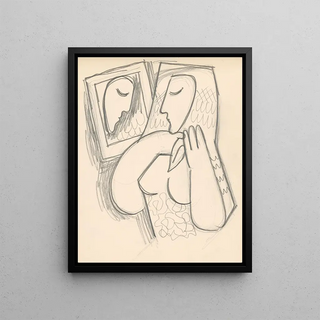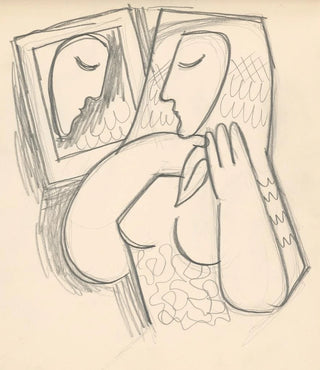Art print | Woman with a mirror - Mikuláš Galanda


View from behind

Frame (optional)
Mikuláš Galanda's "Woman with a Mirror" art print is an iconic piece that transcends the simple frame of painting to become an exploration of themes such as beauty, reflection, and introspection. In this artwork, the artist manages to capture not only the image of a woman but also the essence of her inner world, inviting the viewer to delve into a universe where gaze is lost between appearance and reality. The composition, both delicate and powerful, evokes an intimate atmosphere, where every detail—from the play of light to facial expressions—contributes to a fascinating visual narrative.
Style and uniqueness of the art print
Galanda's style is distinguished by its ability to fuse elements of realism with an almost dreamlike sensitivity. In "Woman with a Mirror," the chosen color palette evokes a range of emotions, oscillating between softness and depth. The subtle nuances of light, carefully crafted, highlight the contours of the face and the mirror, creating a dialogue between the object and its reflection. This play of mirrors, both literal and metaphorical, raises questions about identity and self-perception. The woman depicted appears both aware of her image and lost in her thoughts, symbolizing the duality of the human being in front of their own reflection. This art print is not just a portrait; it is an invitation to contemplation and reflection on the human condition.
The artist and his influence
Mikuláš Galanda, a major figure in Slovak art, left his mark on his era through an innovative and personal approach. Influenced by the artistic currents of his time, he developed a style that is uniquely his own, blending tradition and modernity. Galanda was a pioneer in exploring the psychology of characters, seeking to express deep emotions through streamlined compositions. His work had a significant impact on subsequent generations of artists, encouraging a search for authenticity and depth in human representation. Through his art prints, he established a dialogue between art and life, offering new perspectives on the human experience.
A wall decoration of

Matte finish

View from behind

Frame (optional)
Mikuláš Galanda's "Woman with a Mirror" art print is an iconic piece that transcends the simple frame of painting to become an exploration of themes such as beauty, reflection, and introspection. In this artwork, the artist manages to capture not only the image of a woman but also the essence of her inner world, inviting the viewer to delve into a universe where gaze is lost between appearance and reality. The composition, both delicate and powerful, evokes an intimate atmosphere, where every detail—from the play of light to facial expressions—contributes to a fascinating visual narrative.
Style and uniqueness of the art print
Galanda's style is distinguished by its ability to fuse elements of realism with an almost dreamlike sensitivity. In "Woman with a Mirror," the chosen color palette evokes a range of emotions, oscillating between softness and depth. The subtle nuances of light, carefully crafted, highlight the contours of the face and the mirror, creating a dialogue between the object and its reflection. This play of mirrors, both literal and metaphorical, raises questions about identity and self-perception. The woman depicted appears both aware of her image and lost in her thoughts, symbolizing the duality of the human being in front of their own reflection. This art print is not just a portrait; it is an invitation to contemplation and reflection on the human condition.
The artist and his influence
Mikuláš Galanda, a major figure in Slovak art, left his mark on his era through an innovative and personal approach. Influenced by the artistic currents of his time, he developed a style that is uniquely his own, blending tradition and modernity. Galanda was a pioneer in exploring the psychology of characters, seeking to express deep emotions through streamlined compositions. His work had a significant impact on subsequent generations of artists, encouraging a search for authenticity and depth in human representation. Through his art prints, he established a dialogue between art and life, offering new perspectives on the human experience.
A wall decoration of






